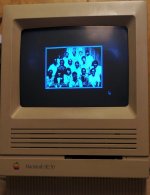tt
Well-known member
Besides the benefit of having a 32-bit clean ROM, an SE/30 can boot off of a CD-ROM drive by holding Command+C at start-up. I tried it with an Apple Legacy CD and it proceded to boot as far as the install could. I also could read CD's without the CD-ROM extension installed.
Another thing I tried out is the IIci easter egg where if you set the system clock to Sept 20, 1989 and hold Command+Option+C+I, it shows an image of the development team. Here is the result:

There are probably other interesting differences, but I'm hoping someone will be able to replicate a Classic boot disk add-on to act as an emergency recovery image.
Another thing I tried out is the IIci easter egg where if you set the system clock to Sept 20, 1989 and hold Command+Option+C+I, it shows an image of the development team. Here is the result:

There are probably other interesting differences, but I'm hoping someone will be able to replicate a Classic boot disk add-on to act as an emergency recovery image.
